So long does it take for a cat to adjust to a new home? Are there things we can do to speed up the process? On average, most kittens adapt the quickest to a new home, only needing about 2-3 days to be comfortable in their environment. Adult cats can take up to a week before they fully adapt to the new environment. With a few preparations and skills – cat parents can drastically reduce the time they need to adjust and begin to create a long-lasting bond with feline family members.
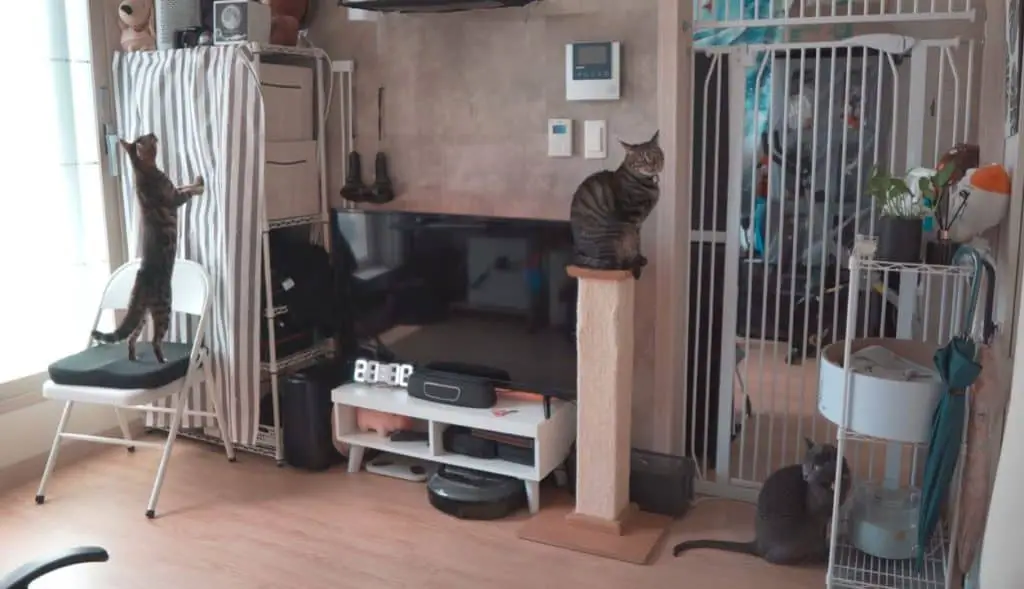
There is nothing more exciting than a new cat or kitten in the house, but if your cat has trouble adjusting to the new environment, it can also cause a lot of anxiety and stress for you and your family. Change is hard for everyone, especially for a new owner. This article will help you to take action to comfort your cat or kitten during periods of significant change.
Note: this guide assumes that the cats are healthy and have been checked by the vet to ensure there aren’t any underlying conditions. This guide also assumes that a cat’s necessary items are available: scratching post, litter box, toys, water bowls, cat appropriate food, etc.
In the sections below, you’ll find tips on how to make the transition for cats as easy as possible, as well as a chart that can help you estimate how long it will take your cats or kittens to adapt to changes. Suppose you’re introducing a new cat in a home with multiple cats. In that case, I have a complete illustrated guide here to make your experience as easy as possible: Cat Introductions With Illustrations!
Cat Adjustment Time VS Cat Age: Quick Glance Chart
Although these times can vary, the information in the chart reflects the general statistics I’ve recorded over years of working with cats and introducing them to new environments and homes. The chart also considers the cat’s age and provides an approximate adjustment time for each situation.
| Cat Age | Expected Introduction Time (With Environmental Preparations) | Expected Introduction Time (Without Any Environmental Preparations) |
|---|---|---|
| Most Kittens (Under 6-7 months of age) | 2-3 days | 3-5 days |
| Domestic Adult Cats (1+ Years) | 3-5 days | 5 days-1 week |
| Domestic Mature Adult Cats (7+ Years) | Several days | Several days |
| Domestic Senior Older Cats (10+ Years) | Several days to weeks | Several days to weeks |
| Feral or Stray Cats | Add an additional 4-7 days | Depending on the cat, add up to 1 week |
Looking at the chart, the difference between the home or room with the environmental preparations and the place without environmental preparations is quite drastic. Additionally, it’s clear that the older the cat, the more time it takes to adjust to its environment.
So even though the preparations might take some effort, it saves a lot of time in the long run, in some cases cutting the adjustment or introduction time in half.

Feral or stray cats that haven’t had proper socialization might take longer as it might be their first time in a home, or it’s been a long time since they’ve been taken in. There are times in which I’ve seen feral/stray cats adapt to their situation super quickly. Therefore, it can vary greatly. So for feral cats especially, take it slow and carefully.
Room/Environmental Preparations For a Cat to Adjust to New Home Quickly
The environment that any cat gets into plays a massive part in their adjustment time. Suppose a cat is given a home or room designed with an eye on how it might live and travel throughout it. In that case, the adjustment period can be reduced significantly because cats are more confident when they know their environment well.

Before you continue, if you need the ultimate guide on having a cat in a small space or apartment to cover this topic and more: The Wonderful Beginner’s Cat Guide!
Create Cat-Centric Spaces For a Cat’s Confidence
If there’s one thing that differentiates cats from other animals, cats are both predator and prey, which means they’re pretty particular about how they like their environment to be. They want to feel safe at a distance but, at the same time, know what’s going on around them.
As a result, cats have a propensity to climb or jump to vertical areas or platforms and seek out new places to find security. Therefore, having a catified home to allow all of these things helps cats adjust greatly by providing an excellent ‘surveying’ point and a secure spot to get away from uncomfortable situations.
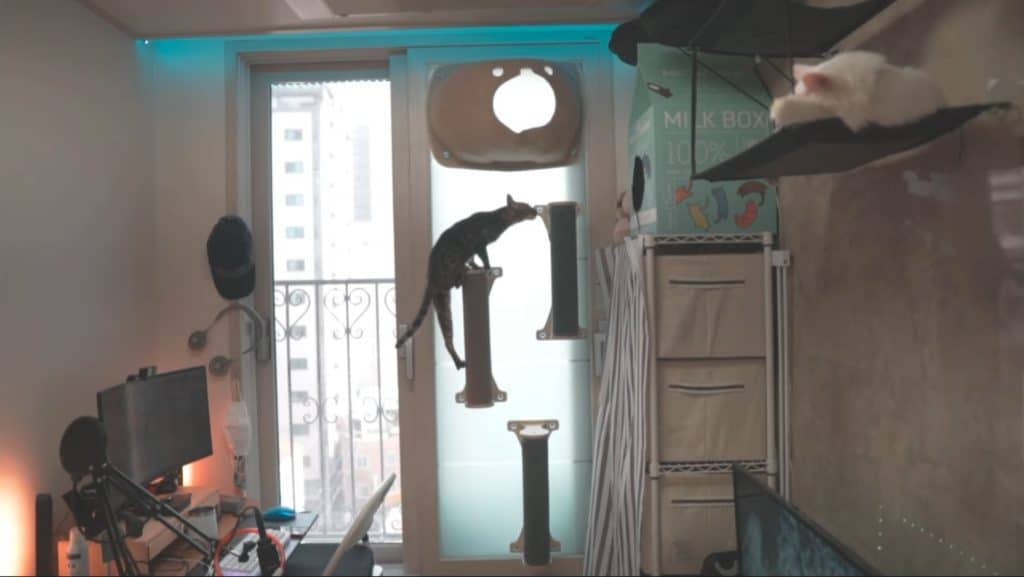
There are many ways to do this cheaply, too (check out the best budget ways for catification here!). Catifying doesn’t require as much effort as you think. Moreover, it’s a fun way to get into the mindset of a cat. Here are the best ways to catify without using too much effort or money:
- My favorite, using suction cup perches on windows and glossy surfaces.
- Modifying existing furniture such as racks and bookshelves.
- Moving and organizing existing furniture in a way that provides cats a path to navigate.
- Providing partially enclosed spaces when they want security (such as boxes or cat beds).
- Use hanging items for cats to climb or jump on.
- Of course, cat trees and poles can also be useful.
For a full curated list of the best cat furniture that I recommend, click here!
Push a Cat’s Comfort Zone by Blocking Off ‘Unders’
The next part in home preparation is blocking off your furniture’s ‘unders,’ such as underneath beds, couches, and other furniture. It’s very common advice, but no one does it because the reason was relatively weak.
However, the real reason for blocking off all the ‘unders’ is so that your cats can continue to test their comfort zones in their new surroundings. A nervous or timid cat will take longer to explore and adapt to its environment if there’s a dark hole or space to go into. The cat has limited knowledge of its environment because of the lack of sights and smells.
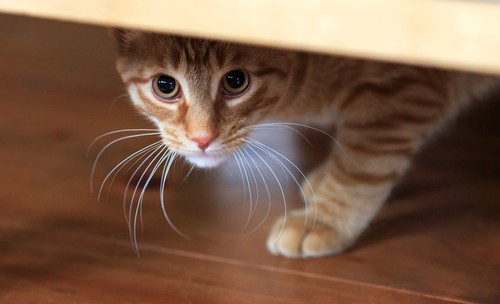
Although it may feel safe temporarily for the cat under these dark spaces, it generally doesn’t let the cat grow into its new space.
With the ‘unders’ blocked off, they’re forced to go elsewhere in the home. As a result, in most cases, these are higher, elevated places that allow them actually to see their environment. Or they are places where the cats can leave their scent and create their zone within the new home.
How To Make a Cat Feel More Comfortable in Its New Surroundings
On the first day or two, many new cat owners feel compelled to try every way possible to make the cat more comfortable by touching the cat from the getgo without establishing a line of trust. Doing this, however, can often create unnecessary stress and could prolong the time that the cat needs to adapt.
There are a couple of things that we can do without directly physically interacting with the cat and, thus, speeding up the process.
Strategy 1: Play & Distractions
The longer a cat isn’t thinking about its environment, the less it feels threatened by the change. Therefore, even distracting them for a certain amount of time (10-30 minutes) can help the cat adapt.
However, don’t just put toys in front of their face. Let cats see the toy moving around in the space and allow them to focus on it if they move and try to play with it, even better. But even just a little attention to the toy has a positive effect.
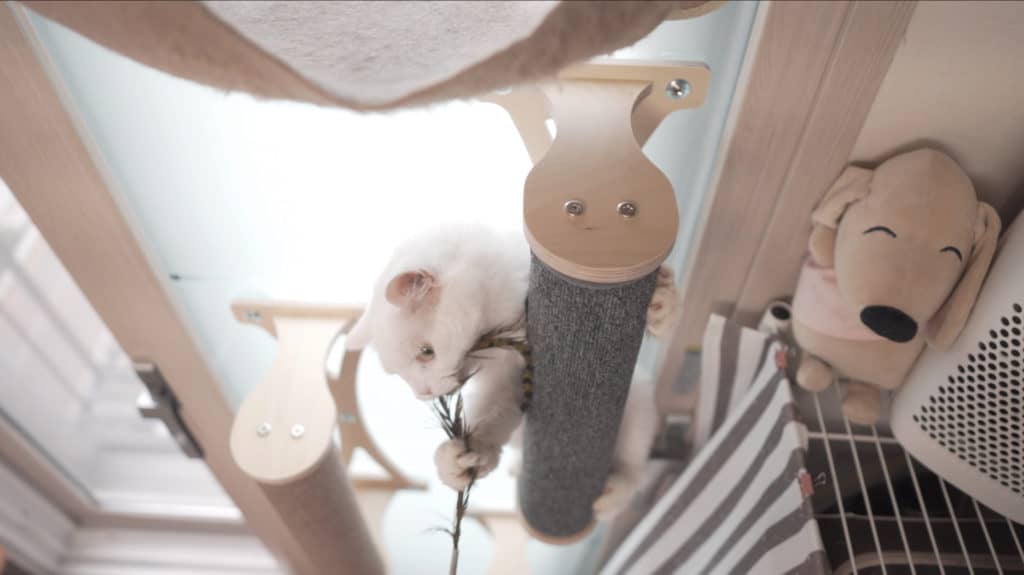
You can use interactive wand tools or laser points to achieve this. Let them follow it for a certain amount of time, then put it away and do it later. A cat gaining more confidence in its environment will be more likely to move, swat, and chase the object or toy. Therefore, if you see increased gradual movement from the cat, that is progress.
Strategy 2: Using Food for Motivation
A hungry cat is a cat that can be trained and guided (since most cats are very food motivated). Don’t let them free feed. If you still have the ‘unders’ available, never leave food under these spaces. Let the food be a reward for pushing their comfort zone.
Give them a treat if they move or explore a new zone that they’ve never been to before. It will reinforce that the home is nothing to be threatened by and give them positive associations with you and the area around them.
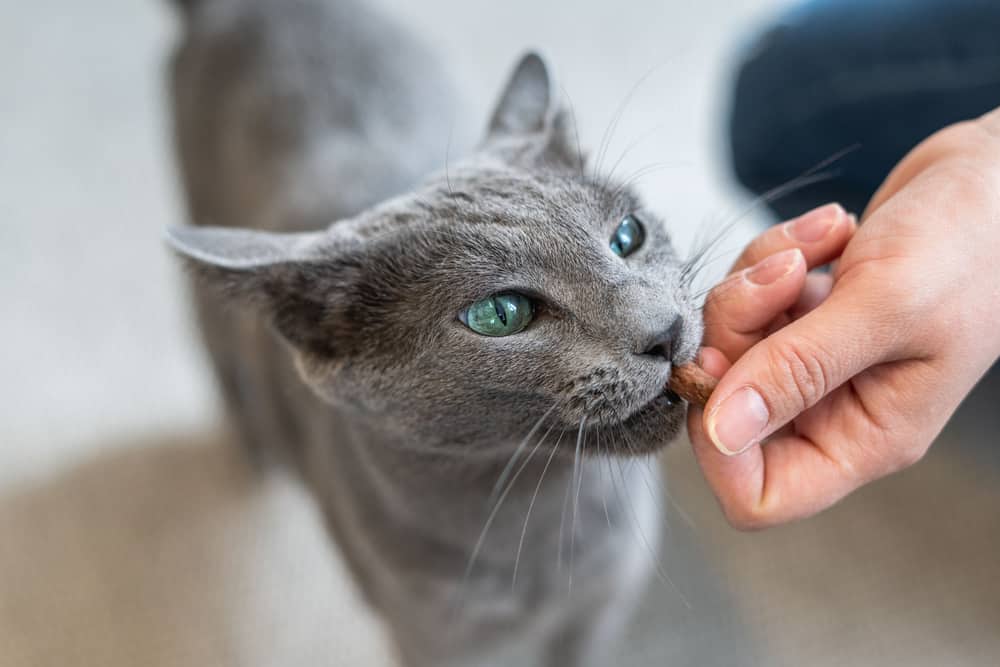
Other Notes & Tips For Cats to Adjust to New Home
In my experience, starting with play and distractions is the best because it is a very hands-off and effective approach without causing any stress. It’s great to do for the first day that the cat arrives.
As cat parents wait and observe, the feline might begin to move around and explore. At that point, try a little hand-feeding, and see how the cat or kitten reacts. If they eat from your hand, you can progress further next time with hand-feeding and gentle touching. Once they learn to trust your hand, it sets them up for the future to be touched, pet, or even held.
Eventually, the cat will get to the point of complete trust with you and its environment. If you’re still having trouble with getting your cat used to its new environment (or with people around them), this more detailed guide might help: How to Get Your Cat to Like/Trust You Again.
Helping New Cats To Adjust to Another Resident Cat in the Home
Of course, if you have another resident cat in your home, the new cat can be more timid and shy. So if you are introducing a new kitten or cat in your home, it’s a good idea to know the process in which to introduce a new cat.
Putting two cats together without strategies to create a positive association between the two can result in bad relationships or even trauma. There is a universally agreed-upon introduction process and that’s the slow isolation introduction strategy.
Isolation Cat Introduction Strategy
- Designate one safe room for the new cat or kitten to enter. This room must include all the necessities such as the water bowl, food, and their own litter box. Other useful items to include are cat beds, the cat carrier that it came in, and cat toys.
- As the shy cat or kitten gets acclimated to its new house and new territory, you can start swapping cat items. This is so that both cats can start to get used to each other’s smell. For example, swapping cat beds, favorite blankets that each cat has been on or even cat toys that the other cats have used.
- After a couple of days, start feeding each cat on the other side of the door (with the door still closed).
- When there is no sign of hissing, continue pushing the comfort zone each meal time. Cat owners can open the door slightly so that each cat is able see each other while eating their meals.
- Look for signs of hissing, if there is excessive hissing or the cat refuses to eat, bring the food bowl to where it was until the cat is able to eat again.
- Finally, if cats are able to eat together without hissing with the door completely open – the introduction process is complete and the cats should be able to explore each other’s territory without problems.
Other Introduction Tips
- For those that are living in single room homes or studio apartments, it’s still possible to introduce your cats. I have developed and tested ways to introduce cats without isolation or needing a separate room, click here to read. Alternatively, cat owners can also use a baby gate or pet gate to act as a separation if you have a narrow pathway.
- Introductions can take lots of time, patience, and consitency. As your new kitty is quickly learning all types of new habits, it’s important to stick to the strategies to prevent negative behavioral traits from developing.
- Always give a lot of positive reinforcement. So that they can associate the positive feelings with what you want them to do.
Signs That Your Cat Is Adjusting
After you’ve done the necessary preparations and your new cat(s) are in their new home, what are some signs that they might be adjusting well?

Some of the signs that your cats are adjusting are:
- Starting to wander around and sniffing out their new environment. They might walk in and out of their “safe” zone but in general – any sort of exploration behavior or going to new zones is a good signal to know that they’re getting more confident in their new space.
- Getting more interested in toys and other stuff around them. They might engage in play with small items or just check the item’s reaction.
- More grooming behaviors (for example, starting to lick themselves more). Cat’s that feel good will start to keep themselves well-groomed and neat, in comparison, cats that are more stressed out or ill will look a bit disheveled.
- Sleepy or half-closed eyes. Cats that are comfortable in their environment will have “sleepy” eyes. Half-closed eyes show that they’re more trusting of their surroundings.
- Expose themselves out in the open. We might see the cat just sprawled out in the middle of the floor or even flopping over and showing their belly (resist the belly rub!). That’s another good sign of them being comfortable with their environment.
For the full article, read: Signs Your Cat is Adjusting to its New Home
When to Get Additional Help From Professionals
Sometimes, despite our best efforts, some cats might need more help. If the new pet or cat is checked out and healthy from the vet but still showing a lot of signs of stress even after a month or more, this can be a sign that something else is going on such as trauma, abuse, emotional issues, lack of socialization, or even PTSD.
“The reality is that many pets with perfectly adequate, loving backgrounds develop fears, anxieties, and phobias based on lack of socialization to a given stimulus as a juvenile.”
Dr. Liz Stelow, chief of service of Clinical Animal Behavior Service at the Veterinary Medical Teaching Hospital at University of California
According to petmd.com, here are the usual signs of emotional trauma in pets:
- Body shaking or trembling
- Fearful behavior such as continuous hiding for some unknown reason
- Inappropriate urination and/or defecation (litter box avoidance in cats)
- Excessive aggressive behavior when interacted with
Any animal is the sum total of its breeding and upbringing, so a dog or cat whose parents were fearful or who were mistreated or injured may pass along fearful tendencies to its offspring.
Dr. Terri Bright, director of behavior services at MSPCA-Angell in Boston
Other Tools to Help Your New Cat to Adapt to Its New Environment
Of course, there are other tools, and some people have found success with specific pheromones sprays such as Feliway (linked below). Additionally, in my home (a 30 square meter small apartment), I have developed a list of products to help create a stimulating environment for my cats that save space. Check out the recommended products page!
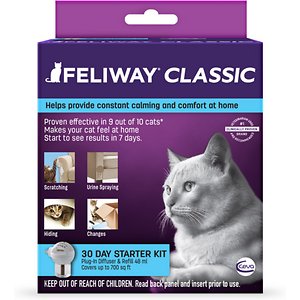 Feliway 30 Day Starter Kit
Feliway 30 Day Starter Kit
Feliway is a synthetic copy of the feline facial pheromone, used by cats to mark their territory as safe and secure. By mimicking the cat’s natural facial pheromones, Feliway creates a state of familiarity and security in the cat's local environment. As a result, Feliway can be used to help comfort and reassure cats while they cope with a challenging situation and help prevent or reduce the stress caused by a change in their environment.

Thank you
He’s doing well. It’s coming up on 2 weeks. I wouldn’t let his original Mom come over until 2 weeks passed.
Linda
I’m happy this article has helped!
Article hasn’t helped me yet as the cat is 7 years old and stays in the spare bedroom or guest bath only. I am going to try hand feeding treats next though. It is almost two weeks and I am having some concerns.
Thanks for your comment! It can be a stressful time for both parties for sure! Older cats will sometimes take their own time to adapt depending on how they were raised when they were young and their current environment! Having as much information of their past life/home is important to try to accommodate them a little more to help facilitate the process along. Good luck!
I have adopted new 1yr old and he too only comes out of the spare room at nights. Any sounds or noises till spook him. I have decided to move the food bowl out of the room to see if it helps. I have been reassuring him and working with him for three to four weeks now and I see glimpses of his real personality here and there but nothing more. IMy sisiter came to visits
and he hid and reacted negatively to her presence. I am at a loss.
Hi my cat is 17 we moved house 2 years ago and now have to move again , we have been in the new house about 10 days . She is feeding well and is dying to go outside , do you think it is wise to let her out
Hi! Thanks for your comment. For me, I would try to give them their outside exposure but only if you are able to create some sort of outdoor enclosure for them so they can’t escape.
There are just too many risks of them getting hurt/lost if they’re left to roam the outdoors freely. Not to mention, they could affect the local wildlife.
Here in my apartment, I plan on cat proofing the balcony so they can’t jump off it!
No. Keep her inside unless you plan on getting her a harness with a leash so she can’t run away
We are day 7 of fostering a 3 year old male cat (neutered the day before he came to us). For 3 days he hid behind the sofa and each day since he has gradually gotten braver, exploring and allowing us to pet him, in fact he loves a head scratch and a belly rub. My little boy loves him. I feed him and clean litter etc, on day 6 he started hissing at me, but would be affectionate afterwards. We have a huge new cat tree for him with many scratching posts. Tonight he started digging up the carpet. For the last 3 nights he has demanded so much attention its become impossible to do anything. I can’t see my husband and I ever watching a movie together again or enjoying just a bit of quiet time – I don’t know what to do. My little boy will be heartbroken if we don’t keep him, but I can’t see how to fix these behaviours and I don’t know how inherent they are already.
Hi! Thanks for your comment. I think it might be just an issue of boredom/pent-up energy. Take a look at this article about how to tire out cats & engage indoor cats – it might alleviate some of these behaviors! With time, it likely solves these issues!
I bought 2 adult cats which is 3 years old about 2weeks one boy other girl they have been with each other from birth that’s why if I buy them together . After 2 weeks the boy still hiding and no come out of his bedroom about the girl she only comes out at night . They are eating and drinking going to toilet but they not settled . How had this experience before ?? Is this normal !! How longe does normally take they be better and come and enjoy with us ???
Hi! It will take a little bit of time for each cat to get used to its new homes. Eliminating places they can hide where you can’t reach (under the bed, cabinet, etc.) is a good start. Having a small and controlled cubby for them is fine but it’s best to block off the ‘unders’ so that they can expand their comfort zone!
Hi! This article was helpful but I’m wondering if you can give some advice. We adopted a cat 7 weeks ago and he has been in hiding since. He comes out at night to eat, drink, play, use the litter box, etc. so he is willing to explore but does not want to be around us. Not sure if you have any specific tips to get him out of hiding especially with how much time has passed?
Hi! Thanks for your comment. One thing to note is that if there are a lot of ‘unders’ (places your cat can hide underneath such as under beds, cabinets, etc.) it’s best to block those from being accessible so it’s easier to push their comfort zones. Have one or two places that they can go for security (a carrier) or a cat bed but otherwise, keep trying to push their comfort zone through food, play, environmental adjustments!
Hi! I adopted a 5 year old cat from the shelter about a week ago and she meows very loudly whenever left alone. Even if I’m only gone for 5 minutes to take out the trash, she starts “yowling” only a few minutes after I’m out the door. She also just seems really anxious in general if I leave my bed room she nervously follows me, and every little sounds has her on edge. She never seems relaxed unless I am laying in bed with her. What can I do? Will this get better with time?
It’ll get better with time definitely but it’s going to require some patience and a bit of willpower. If all of their needs are met and she is healthy, then all that’s left to do is allow her to adapt at her own pace. However, this doesn’t have to mean that you have to be attentive to every sound. If she yowls, don’t make eye contact, don’t give her attention. It will begin to reinforce that type vocalization is not a way to get attention. Put her on a routine. Routine for play and food that they can expect will reduce these attention/anxiety-based behaviors a lot!
Play routine & Mealtime routine
We have two 10-week-old kittens. They are from different mothers. We had the first kitten at 7 weeks, and she has adapted perfectly to her forever home. She is one half Maine Coon and farm cat, and her name is Siggy. The second kitten came to us at 9 weeks. She is a full Maine Coon from champion parents. Her name is Freya.
Freya took four days to adapt to her new home, playing with Siggy. Eating and using the litter box. But she runs away from my wife and me if we come close to her. We have used fishing toys, treats and never pick her up, waiting for her to adjust to us. But we’re beginning to fear that this avoidance might be a long-term thing.
How long does a kitten like this take to adapt to her new parents. We’d love to hold or even touch her, but we haven’t yet. Thoughts?
Hi! Thanks for your comment! I just wrote an article that might help with this here:
https://monsieurtn.com/cat-wont-let-me-pet-or-touch/
Other than that, the key is that you’re around for all those fun activities that you’re doing with the kitten. My youngest kitten, Loki, took awhile to get use to me as well but now he’s the most clingy out of all my cats. So I think it’ll be fine if you keep that routine!
Remember to get low when you approach the kitten and not try to approach head-on.
Keep me updated!
My daughter has a 3 year old female cat she adopted 13 months old at college. She came home last year and the adopted cat was use to an escape proof harness. We would walk her no issues. This Spring we had three incidents while outside during walks. Once she saw a another cat running from the property. Our cat just went crazy, thank goodness for the harness. However we have never heard the this type of LOUD SCARY yowling and hissing before. Her aggression turned on me while holding the leash. I wouldn’t let go of the leash but wasn’t able to get her into the house. She wouldn’t let me pass her. Finally with help from my daughter the cat went into her carrier we brought outside. We asked the vet, he said leave her indoors for 30 days. If you absolutely want to take her wait. We did this. We took her out and this happen 2 more times only after a scent she got (not seeing another cat) but on a bit smaller scale but not good. What happened to our sweet quiet cat? We still don’t know. Environment Agression? Will she now be just an indoor cat.? We’re too scared to try outside again. Thank you
Yes, you’re right – it’s territorial aggression. Your cat was quite okay with roaming around but when it found other cats there in its territory, it went into the defensive. In my opinion, because of the frequency that it’s happening, it’s probably time to make some sort of a cat enclosure (or purchase) in a spot where you’re sure there won’t be other cats to let them roam and experience the outside. If not, then just make your home as cat-friendly as possible through catification and bringing as much of the outside in (cat-friendly plants, access to more windows, maybe even a bird feeder to allow the cat to see some wild-life).
Hello, i adopted a 4 month old kitten 3 days ago and she just keeps hiding in a dark corner behind my desk. She lets me pet her and purrs and rubs her head against my hand and lets me pet her body, but then she gets really scared and runs back to the nearest corner. She was a fostered stray before i adopted her so she’s not litter trained either and last night at 3 am she kept meowing and circling the entire room and ended up peeing on my bed then running back hiding again. If you have any advice it would be deeply appreciated as this is my first cat ever and i got her after my dog died a few months ago.
The best approach would be to block off areas that she can hide, for example, I would block off that area of the desk! Lure her out with snacks and toys and remember not to free feed! She’ll come around when she starts getting hungry! Good luck!
I have a 14 month old and brought home a 16 month old. Both are comfortable with me but hiss at each other. I have the new cat in a separate room. I am using blankets with each scent and put them in each other’s path. . How long is this going to take for them to used to each other? Should I have just had the one cat? Have I made a mistake by having more than one cat?
I think they’ll be fine. Introductions take time. Focus on what we can control as cat owners: routines, food, and environment. See this article for help: https://monsieurtn.com/introducing-a-cat-in-a-studio-apartment/
Hi there. We’ve just adopted 2 beautiful kittens a few hours ago. They’re siblings, one boy and one girl – Both around 14 weeks old. They’ve not eaten or drank or been in the litter tray since they arrived. They’ve just been hiding. For a minute or so they came out. But other than that they’ve been hiding. And when we try getting close they just hiss. It’s starting to worry me. Is this normal?
This is definitely normal. Luckily, kittens are the quickest to adapt. Just keep trying to lure them out with fun toys and activities! Keep them away from dark corners and furniture undersides!
I just adopted a 6 year old cat 3 days ago. I concerned because he hides alot, only has came out once for me to pet him, and as far as I can tell has not eaten or drank anything. What can I do to help him
The concept that we cat butlers need to try to understand is that we cannot control the cat but we can control their surroundings. Make sure his environment is set up well, catified, and be patient!
I just picked up the sweetest 6 year old tuxedo, and she is doing very nicely. I tend to set them up in my room closed off for the first night, so she gets to wander around the room, bathroom and closet.
We hang out and I try to be available, but not smother her.
Today, I have opened the door to the rest of the house, but I stay centralized and visible, so when she gets nervous or need reassurance, she can see me and check in.
It’s going well!!
I just got a 2 year old female spayed cat. My cat I already had, I got him as a kitten, is about 1 1/2 years old. He was neutered already. He wants to get to know her and follows her at a distance but every time he tries to get closer to her, she hisses and growls at him. I only have her for a couple of days now and they are okay sleeping in the same room and even share a litter box even though I have 2. Is that a good sign that eventually they will be able to play and snuggle together?. I don’t want to have to take her back but I want them both to be happy and she doesn’t seem to like to have another cat around
In August our son got married in another state. We had good caretakers, and I might add the were indoor/outdoor cats as we live on a farm. Our caretakers never saw our cats, which is unusual. When we got home, they were nowhere to be found. Not only are we heartbroken, but our dogs are too, who adopted the cats as their babies. We are doing a trial with a 5 year old tortoiseshell. She’s sweet but hisses and growls a lot. Should we have started with a kitten so it would have a better chance of bonding? Would bringing a 2nd cat in be beneficial or make things even worse?
I have 8 cats all males ranging from 8 years to 18 years old . We moved two miles down road . 3 out of 8 stayed . The other ran back through the woods and found the old house of the last 13 years .. I brought to new house mutible time and kept them inside for two weeks or longer and as soon as I open door they run back . The new home owners are gonna call the pound . What can I do to make them stay . I’ve done all sorts of stuff . Nothing works . I’ve tried bringing one at a time or two at a time . It’s been 3 months . I have no other option. Help me
Try putting some of the used litter in a shallow box OUTSIDE near your homes door that you let them out of. They smell thier way home…so if your old yard has thier potty odor….they will seek it out.
My parents have 4 cats and over the past year, one has become increasingly aggressive with the others, leading to some violent altercations and 2 of the other cats living in fear of her. We have tried giving her a room that only she can get into with her own litter box and food as well as many other things with no improvements at all. Unfortunately, we have decided that rehoming her is our only option for her happiness and that of our other cats. I currently have her with a friend who is fostering her while we looking for a home. My friend said that she was great for 2 days and now she won’t come out from under the bed, is growling at her, and seems depressed. Any suggestions?
I recently took my mother in laws 6 yr old kitty.
Kitty was at her side til death. We took kitty just a couple hours later. We have some of her things here so smells are here. However she seems so very frightened. How to help her to trust?
Thank you for the ideas here. I work with a rescue and we get cats at various stages of comfort and security. I plan to print this off (if I may) and share it with other humans in our rescue, so we can all be on the same page and using the same methods, along with what we are currently doing. It is also a great resource for our adoptive parents.
Of course! I’m glad to be of help!
Good afternoon,
I have read some of these posts and also your website is very helpful. We are adopting a 5 month old kitten on the 12th August. We have had grown up cats n the past, both rescues, so the kitten thing is totally new to us. We are coming up to some seriously hot weather again and need to have the rooms aired in the house but are conscious of not letting him out into the back garden in case we lose him. Any suggestions?
I adopted two 10 y/o cats last week. I set up a spare room for them with food, water, litter boxes, toys, and soft places to sleep. Well, they are still in hiding, mostly in a storage closet, and one still sometimes hisses when I come into the room. How long do I keep them in this one room? At what point is it OK to open the door and let them roam? I have a fairly large house with lots of hidey holes so I’m a bit worried that if I let them roam I will never see them again. But is it healthy to keep them enclosed in one room for weeks? I’ve had cats all my life, but this is a first for me, and I’m at a loss.
Hi! I need help with my newly adopted 5-year-old cat. We adopted her 4 days ago and she’s super friendly – has roamed our tiny apartment on the first day and has been sleeping with us since the first night. But she eats very less, once every 24 hours or even less than that and she vomited yellow liquid recently. We don’t exactly know what to give her since she’s new. She doesn’t eat the shelter food so we gave her the random cans we picked up for free from the shelter. She wouldn’t eat those either. So we dont have a diet in place for her. Any help would be appreciated!
hi! i’m thinking of adopting a kitten that will be ready to go home in June. my only concern is that we’re planning on moving apartments 1 month later in July – i’m concerned that introducing her to a new environment in June to just put her in a different one a month later would be too stressful for her and make her not trust or like me so early on. do you have any tips? would it be better if i looked into adopting a different kitten after we’ve moved apartments?
I have a new cat and one resident cat the new one sometimes lunges at the other one but it’s not like a cat fight it’s just lunges at the other one. I’m at the stage where they can see each anotherother and stuff sometime is it the new one will get close to each other and not lunge and etc. should I return the new cat due to this aggression or is it aggression? I got the new cat May 5. The new cat is year and six months and the resident cat is 12 years old I keep them separate during the night because I made sure the resident cat is safe and OK but I don’t know what to do it’s now July 3 sometimes she does this one sometimes she doesn’t. I’m so confused and I don’t know what to do. I don’t want to give her bad but I’m so confused. Help help help